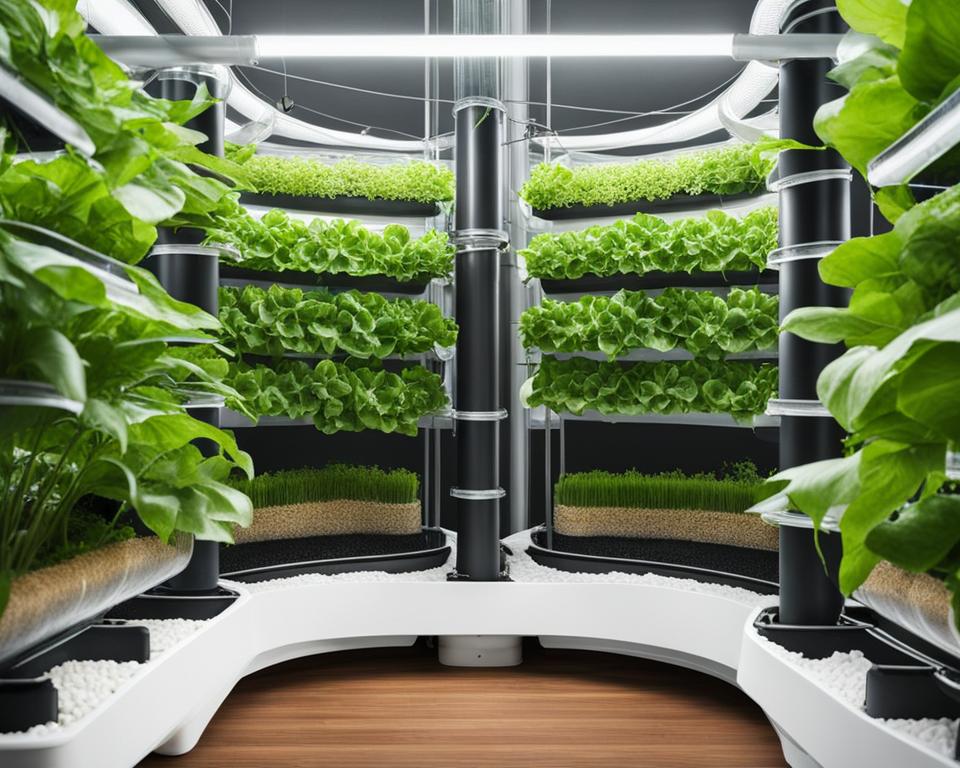Welcome to the future of farming right in your backyard, or even on your balcony. You’re about to embark on a journey with vertical aquaponic gardening, an innovative and sustainable gardening method that blends the beauty of green growth with the eco-minded ethos of our times. This farming revolution optimizes your available space and resources to foster a thriving garden that’s both eco-friendly and organic. Imagine cultivating lush plants and nutritious fish together in a space-smart and water-wise setting.
Key Takeaways
- Vertical aquaponic gardening is a fusion of aquaculture and hydroponics that capitalizes on vertical space.
- It promotes eco-friendly gardening practices by minimizing the ecological footprint through water recycling and elimination of chemical fertilizers.
- An ideal sustainable gardening choice for urban settings, where ground space is at a premium but the desire for green living grows.
- Adopting vertical aquaponic systems can lead to an increase in organic gardening practices, vital for health and environment.
- Participants can look forward to harvesting both fresh produce and seafood from the comfort of their home.
The Concept of Vertical Aquaponic Gardening
If you’re interested in urban farming or small space gardening, you may have heard about vertical aquaponic systems—an ingenious solution that combines the best of hydroponic systems with aquaculture. Vertical aquaponic gardening empowers you to grow a diverse range of plants in vertical columns that sit conveniently above a fish tank, thereby creating a symbiotic ecosystem within your very own living space.
This method hinges on the nutrient film technique (NFT), a process often seen in hydroponic systems, innovatively altered for vertical invocation. The beauty of this system lies in its clever use of vertical space, enabling the cultivation of more plants within each square foot. Not to mention, the gravity-fed water system elegantly reduces complexity, improving irrigation and circulation without the need for elaborate pumps. Customizable and adaptable, these systems invite those with even the smallest footprints to transform their balconies, patios, or indoor spaces into thriving green gardens.
One of the prime advantages of this type of system is its remarkable utility in urban farming. As cities become denser, the need for innovative solutions like vertical aquaponic systems is paramount. They not only provide high-density, nutritious food options but also bring greenery and vitality to often gray urban landscapes.
- Maximized usage of vertical space for plant cultivation
- Reduced water usage compared to traditional farming methods
- Opportunity for urban dwellers to engage in sustainable food production
| Feature | Benefit | Relevance to Gardening |
|---|---|---|
| Vertical Structure | Increased plant density | Perfect for small space gardening |
| Nutrient Film Technique | Efficient nutrient delivery | Enhances plant growth without soil |
| Gravity-Fed Water System | Reduces need for water pumps | Lower energy use and sustainability |
In conclusion, the rise of vertical aquaponic systems heralds a new era for urban farming and small space gardening. By using this approach, even those living in the heart of concrete jungles can experience the joys and benefits of growing their own fresh produce. It’s a testament to human ingenuity and our desire to harmonize with nature despite spatial limitations.
Understanding the Vertical Aquaponic System
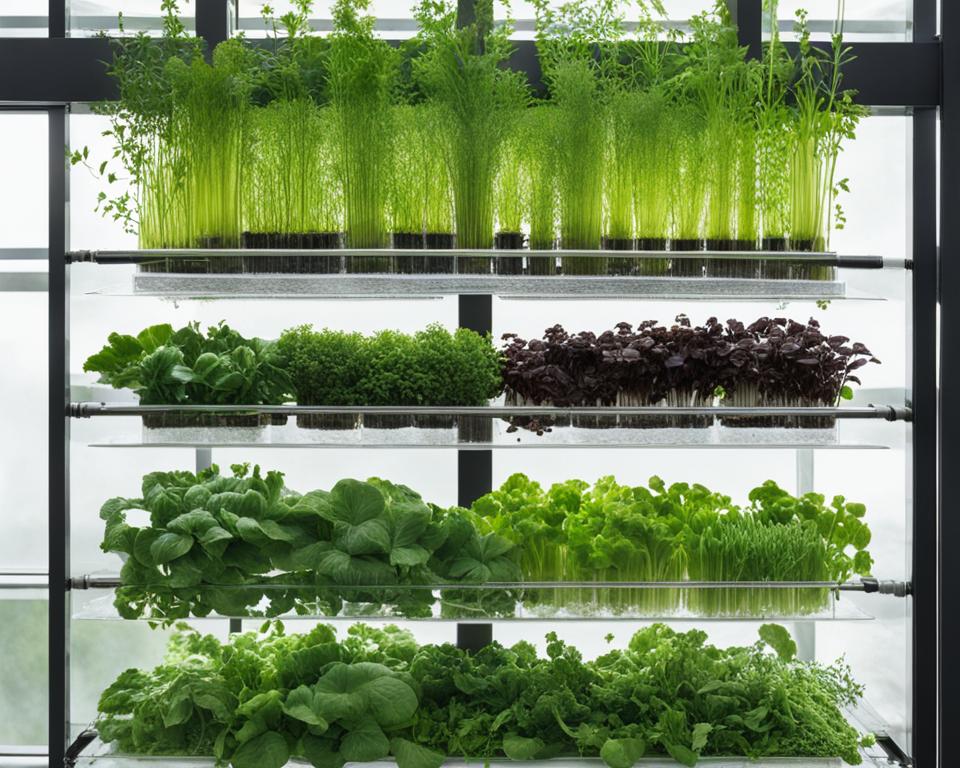
Vertical aquaponic gardening is transforming the face of urban farming, enabling enthusiasts and city dwellers to cultivate lush, self-sustaining gardens within the comfort of their homes or community spaces. These aquaponic systems merge the best of both worlds in indoor gardening; by combining aquaculture with hydroponics, they pave the way for a harmonious growth cycle between fish and plants.
Components Necessary for a Vertical Aquaponic Setup
A well-designed vertical aquaponic system requires several key components that work in unity to support both plant and aquatic life. Here’s a breakdown:
| Component | Function | Importance |
|---|---|---|
| Fish Tank | Houses the fish whose waste provides nutrients | Essential for the nutrient cycle |
| Plumbing | Ensures water circulation between the tank and plants | Crucial for water distribution and waste removal |
| Growth Pipes | Supports the root systems of plants | Allows for vertical planting, maximizing space usage |
| Water Pump and Aeration System | Transports and oxygenates the water | Keeps fish healthy and aids in nutrient absorption for plants |
| Lighting System | Provides necessary light for plant photosynthesis | Indispensable for indoor setups lacking natural sunlight |
How Vertical Systems Enhance Urban Farming
Vertical aquaponic systems are a game-changer, especially in the urban environment where space is at a premium. These systems enable you to grow a variety of crops year-round, from leafy greens to fragrant herbs, by simply utilizing vertical spaces such as walls or balconies. Their modular nature also means they can be expanded or customized to suit individual needs, making vertical aquaponic gardening a truly versatile and innovative approach to city living.
Adopting such systems not only brings the joys of gardening into your home but also contributes to sustainable living efforts, creating a greener, healthier urban life. Whether it’s a desire to grow your own food or to greenify living spaces, vertical aquaponic systems offer an effective, eco-friendly solution for modern indoor gardening.
Benefits of Vertical Aquaponic Gardening
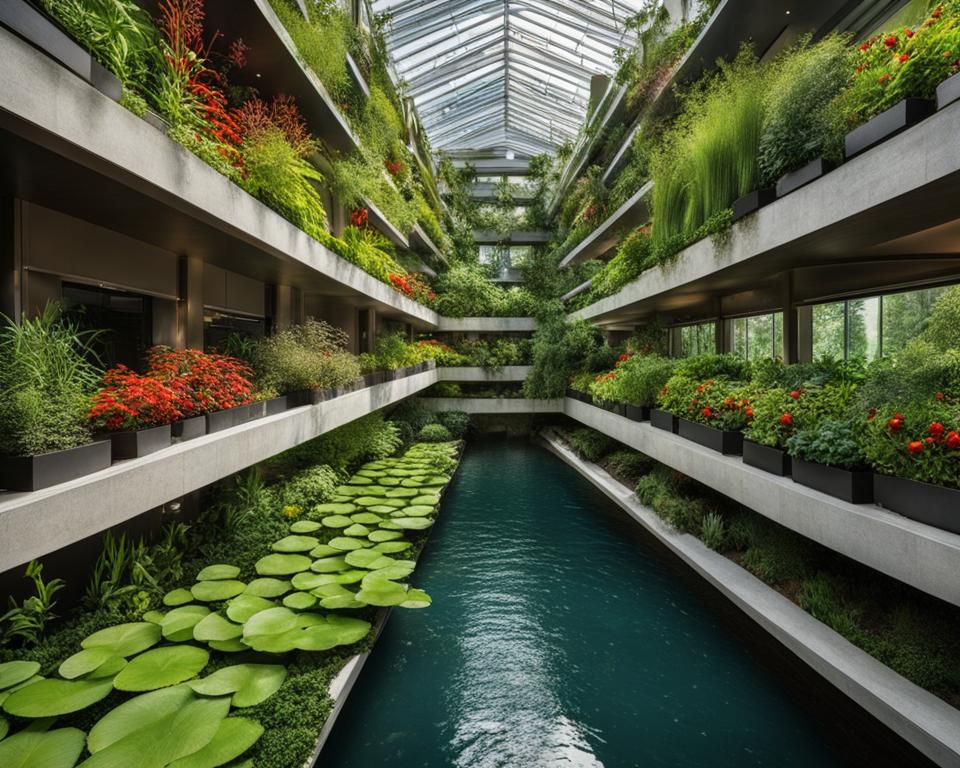
As the interest in sustainable gardening practices grows, vertical aquaponic gardening has emerged as a transformative solution for gardeners everywhere. This innovative approach not only aligns with organic gardening principles but also serves as a hallmark of eco-friendly gardening. Below, we’ll explore the unique advantages this gardening method offers, particularly in urban settings where space is at a premium and efficiency is key.
Space Optimization in Small Gardens
One of the most prominent challenges that urban gardeners face is the lack of space. This issue, however, is cleverly navigated through the implementation of vertical aquaponic systems. What makes these systems so effective is their ability to maximize vertical space, turning even the smallest of areas into lush, productive gardens. Whether you have a tiny patio or just a corner of a sunlit room, vertical aquaponics can transform that space into a verdant oasis.
Water and Resource Efficiency
Another pillar of vertical aquaponic gardening is its astoundingly efficient use of resources—a core tenet of eco-friendly gardening. The closed-loop system recirculates water between fish tanks and plant beds, conserving precious H2O and abolishing the need for chemical inputs. Not only does this minimize water consumption, but it also ensures that your garden’s ecosystem is completely organic, playing a pivotal role in the pursuit of sustainable gardening.
The Heart of Vertical Aquaponic Gardening: The Fish Tank
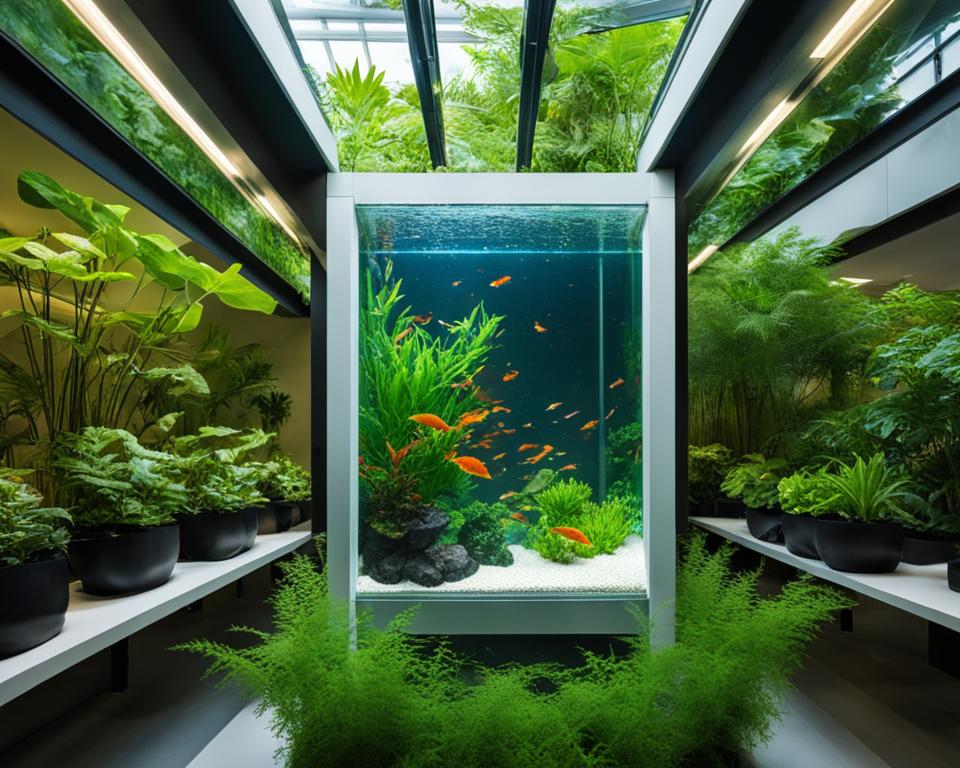
At the core of any successful vertical aquaponic gardening endeavor lies the fish tank, an intricate provider of nutrients and a home for your aquatic companions. Your choice in fish plays a pivotal role in the functionality and flourishing of your sustainable gardening project. But it isn’t just about having a fish tank; it’s about creating an environment where both fish and plants can thrive harmoniously, reinforcing the delicate balance that makes aquaponic systems so innovative.
Choosing the Right Fish for Your System
When it comes to vertical aquaponic gardening, not just any fish will do. You need species that are adaptable, hardy, and able to thrive in the created aquatic conditions. Factors such as water temperature, pH levels, and the companion plants in your aquaponic system will influence your decision. Popular choices like tilapia and goldfish are known for their resilience and compatibility with various plant types, making them ideal for beginners and experts alike.
Maintaining Healthy Aquatic Conditions
For your aquaponic systems to succeed, monitoring and maintaining healthy aquatic conditions are paramount. Regular checks on water quality, including parameters like ammonia, nitrate, and pH levels, are essential for fostering a thriving ecosystem. Oxygenation through proper aeration keeps your fish vigorous, which in turn ensures that your plants receive nutrient-rich water, bolstering the heart of your sustainable gardening efforts.
Planting in Vertical Aquaponic Systems
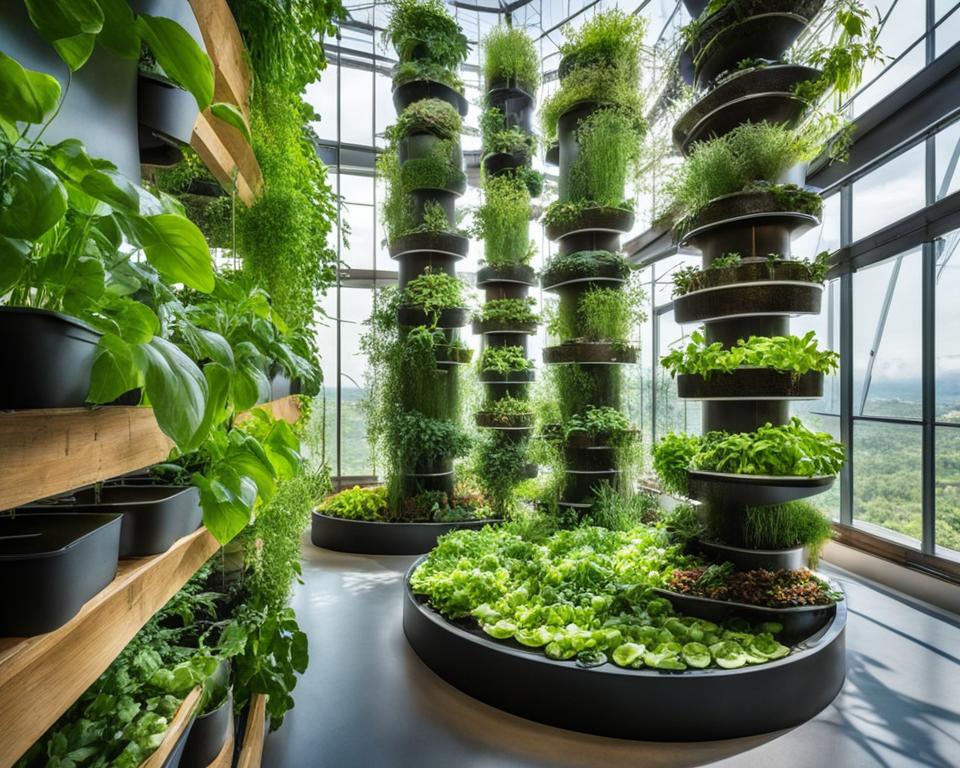
Embracing vertical aquaponic gardening means entering a world where space efficiency and plant productivity go hand in hand. As you consider the vertical expanse of your indoor garden, selecting plants that not only thrive in a columnar environment but contribute to the sustainability of your organic gardening efforts, becomes paramount. Such a system, when properly implemented, promotes robust growth of greens and herbs, all the while contributing to the delicate balance of your ecosystem.
Selecting Compatible Plants for Vertical Growth
When contemplating the variety of plants for your vertical aquaponic systems, the goal is to combine aesthetics with functionality. Look for plants characterized by quick growth rates and shallow root systems such as lettuce, spinach, and a range of aromatic herbs. These are not only resilient but are well-suited to the vertical framework, allowing for maximized growing space in your indoor garden.
Nutrient Distribution and Plant Health
In a well-designed vertical aquaponic system, nutrient-rich water is a byproduct of the aquatic life that forms the foundation of your setup. To ensure uniform nutrient distribution and optimal plant health, consider staggering your planting. This approach not only ensures that all plants receive the nutrients they need but also helps in maintaining consistent water quality, essential for both plant and fish well-being.
| Plant Type | Growth Rate | Root System | Nutrient Requirements |
|---|---|---|---|
| Lettuce | Fast | Shallow | Low to Moderate |
| Spinach | Fast | Shallow | Low to Moderate |
| Herbs (e.g., Basil) | Moderate to Fast | Moderate | Low |
| Strawberries | Moderate | Shallow | Moderate |
Integrating Vertical Aquaponic Systems into Greenhouses
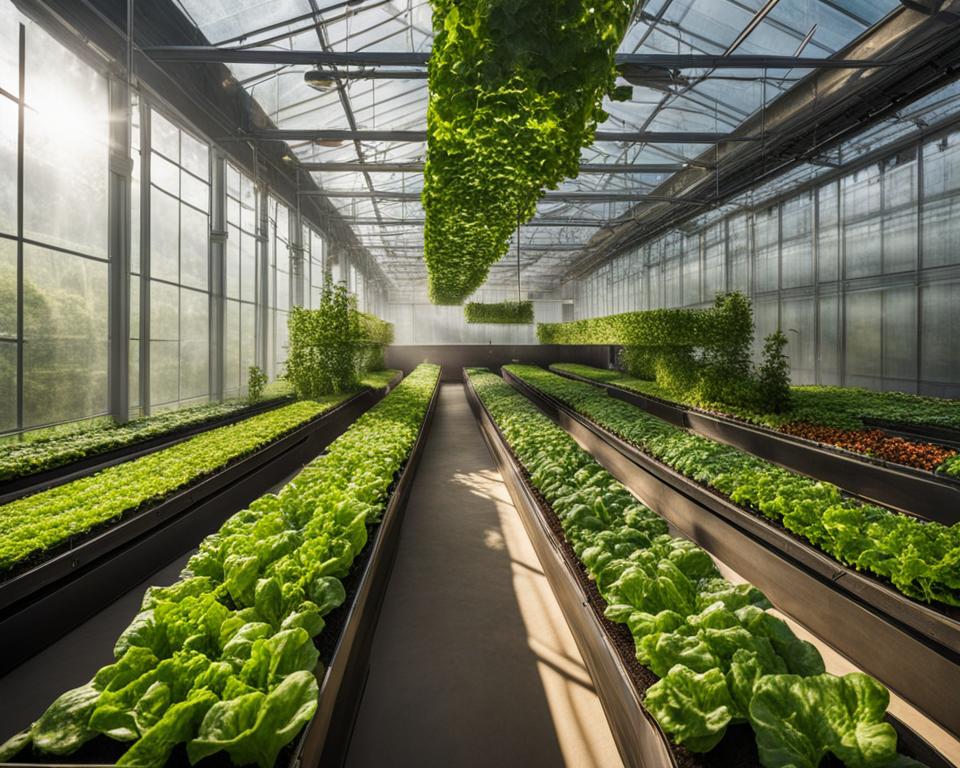
When we talk about merging the best of vertical aquaponic gardening and eco-friendly farming, the aquaponic greenhouse emerges as a prime innovation. This symbiosis allows you to harness the year-long benefits of controlled climate conditions, essential for optimizing the productivity of both plants and fish. Such integration signifies a leap in sustainable farming methods, ensuring that each variable—be it temperature, humidity, or light—can be accurately managed to aid crop growth.
Protecting your aquaponic ecosystem from external climatic fluctuations and pests, a greenhouse enables the growth of a wider variety of crops that might otherwise struggle outside. The melding of these systems generates a micro-environment that fully embodies the closed-loop principles, making every square inch count both in space and resource efficiency.
| Feature | Benefits | Considerations |
|---|---|---|
| Controlled Environment | Year-round crop production | Maintenance of greenhouse structure and climate control systems |
| Space Efficiency | Maximized plant density and diversification of crops | Need for precise system design and planning |
| Resource Conservation | Reduced water use and waste | Initial investment and setup costs |
| Pest Management | Minimized pest infestations | Ongoing monitoring and natural pest control methods |
In essence, enveloping your vertical aquaponic system within the protective shell of a greenhouse isn’t just about improving the odds of success; it’s about commitment to a sustainable future where eco-friendly farming is the norm, not the exception. By choosing this path, you’re advocating for a more resilient food system, one that addresses the challenges of modern agriculture without sacrificing the health of our planet.
Step-by-Step Guide to Setting Up Your Vertical Aquaponic Garden
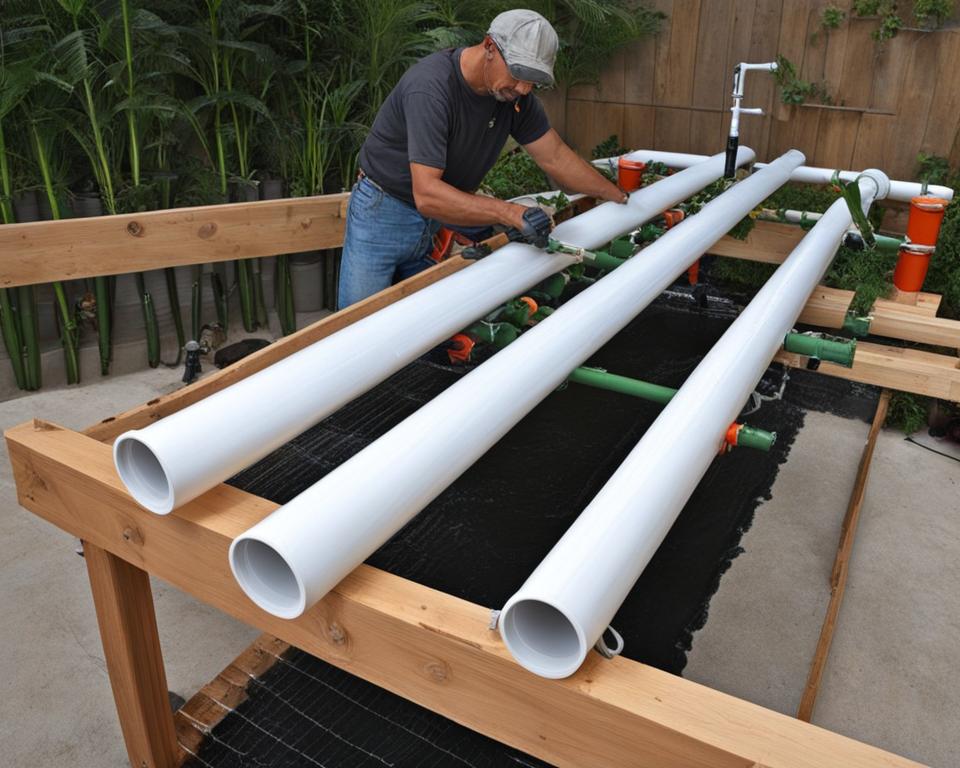
Embarking on the journey of DIY vertical aquaponic system construction or opting for a pre-made vertical aquaponic setup can be an exciting venture for any urban farming enthusiast. Whether you cherish the satisfaction of building something with your own hands or prefer the straightforward simplicity of a ready-to-install kit, establishing your vertical aquaponic garden is straightforward with the right guidance.
DIY Vertical Aquaponic System Construction
If you’re inclined towards a DIY approach, your initial steps involve selecting materials that suit your urban space and personal preferences. The flexibility of designing a DIY vertical aquaponic system allows you to determine the precise size and layout to fit your urban dwelling. Here’s a simplified overview to get you started:
- Select durable materials capable of supporting the weight of water and plants.
- Design the layout, taking into account the vertical growth of plants and access to sunlight.
- Assemble the fish tank and growth columns using reliable plumbing techniques.
- Install a water pump and aeration system to ensure healthy fish and plant life.
- Cycle the system, allowing the beneficial bacteria to establish in the water before adding fish.
Pre-made Vertical Aquaponic Options and Installation
For those who opt for a pre-made vertical aquaponic setup, the process avoids some of the complexities of DIY construction. With options available for different space sizes and requirements, you can select a system that aligns with your gardening goals. Follow these steps once your pre-made system arrives:
- Choose a location with ample light and stable temperatures for your aquaponic system.
- Follow the manufacturer’s instructions to assemble the racks and tank.
- Ensure the system is level to facilitate proper water flow and plant development.
- Start the cycling phase to prepare the ecosystem for your plants and fish.
| DIY System Components | Pre-made System Advantages |
|---|---|
| Customizable design for personal preferences | Convenience and ease of installation |
| Hands-on experience in system setup | Professionally designed for optimal performance |
| Opportunity to learn and apply aquaponic principles | Customer support and warranty |
| Potential cost savings | Time savings and immediate setup |
Whether you decide on a DIY vertical aquaponic system or a pre-made setup, thorough planning and careful execution are critical in creating a flourishing vertical garden in the realm of urban farming.
The Lifecycle of a Vertical Aquaponic Garden
Delving into vertical aquaponic gardening unlocks a world of sustainable possibilities, marrying the beauty of vertical greenery with the natural processes of aquatic life. Your journey through the lifecycle of a vertical aquaponic garden begins with the sprouting of seedlings and culminates in the harvesting of mature plants, a process intertwined with the growth and management of your aquatic population.
From Seedlings to Harvest: Plant Growth Stages
Understanding the plant growth stages is essential to maximizing the yield of your vertical aquaponic system. Each stage, from germination to flowering, presents unique requirements in terms of light, nutrition, and space. Leafy greens, for example, progress through their growth stages with remarkable speed in an aquaponic environment, turning your vertical garden into an efficient organic oasis.
Fish Growth and Population Management
Your aquatic companions are more than just pets; they are a cornerstone of the aquaponic ecosystem, their growth and health directly influence plant progress. Managing fish populations requires a delicate balance—appropriate stocking densities, proper feeding regimens, and vigilant observation are crucial for a thriving garden that epitomizes sustainable gardening ideals.
| Plant Growth Stage | Considerations in an Aquaponic System |
|---|---|
| Germination | Consistent moisture, gentle lighting, and warm temperature |
| Vegetative | Increase in nutrient demand, spacing, and stronger lighting |
| Flowering | Adjust light spectrum and duration to encourage blooming |
| Harvesting | Preparation for crop rotation, clean and sanitize system |
There’s a resounding beauty in nurturing life from seed to harvest, a process that teaches patience and care. As your greenery climbs vertically, you’re cultivating more than produce; you’re raising a monument to organic gardening excellence. With each cycle, enhance your expertise in sustainable gardening, taking pride in your contribution to healthier living and a happier planet.
Maintaining and Troubleshooting Your Vertical System
Regular upkeep and quick problem-solving are vital to ensure your vertical aquaponic gardening experience is successful and fulfilling. It’s not just about enjoying the harvest; it’s also about sustaining a thriving ecosystem within your aquaponic system. A little bit of diligence goes a long way in protecting the longevity and health of your garden.
Dealing with Algae and Water Quality Issues
One of the most common challenges you may face in sustainable gardening with aquaponics is the issue of algae. Algae can quickly proliferate, especially in systems that receive ample light. To control this, consider implementing shading techniques or positioning your system in a way that moderates light exposure. Moreover, it’s critical to monitor water quality regularly. By keeping an eye on ammonia, pH, nitrite, and nitrate levels, and making adjustments as needed, you can prevent toxicity and create a supportive environment for both fish and plants.
Recognizing and Addressing Common Plant and Fish Diseases
Fish and plant health go hand in hand in the delicate balance of an aquaponic system. Any onset of disease can affect your entire system’s productivity. Stay vigilant for signs of distress in both your aquatic and plant residents. Early detection and treatment of diseases, which may range from fungal infections to bacterial blights, are crucial for maintaining system maintenance and overall garden health.
- Examine fish regularly for abnormal behaviour or markings, which might suggest illness.
- Inspect plant leaves for discolouration or spots, which often indicate nutrient deficiencies or infections.
- Implement organic methods for pest and disease management to retain the organic integrity of your aquaponic garden.
- Embrace preventive measures, like proper spacing, pruning, and clean aquaculture practices.
Continued learning and an active approach to system maintenance are indispensable for the efficacy and longevity of your vertical aquaponic gardening endeavors. By staying committed to diligent care and timely troubleshooting, you can enjoy the rewards of a robust, productive, and sustainable garden.
Conclusion
In the dynamic landscape of urban farming, vertical aquaponic gardening stands as a testament to innovation, merging the dual demands of sustainability and space efficiency. As cities grow more crowded and concrete-laden, the ingenuity of this gardening method offers a respite to those longing to grow their own produce. Vertical systems not only maximize limited square footage but also pave the way for high-density, eco-friendly gardens regardless of the season.
The draw of vertical aquaponics lies in its accessibility. Whether you are venturing into the sphere of gardening for the first time or are an experienced cultivator, the simplicity and affordability of these systems provide an encouraging entry point. The ecological footprint is minimal as these gardens employ sustainable gardening methods, slashing water usage and eliminating the need for harmful chemicals, all while delivering a harvest that is as nutritious as it is robust.
By adopting eco-friendly gardening practices through vertical aquaponics, you align with a community committed to nurturing the environment. You support a cycle of life that is self-sustaining – where fish nourish plants, and plants, in turn, purify the water for the fish. It is a symbiotic relationship that not only feeds bodies but also fuels hope for a greener, more sustainable future. Embrace the spirit of vertical aquaponic gardening and cultivate not just a garden, but a vision of harmony between urban life and nature’s abundance.
FAQ
What is vertical aquaponic gardening?
Vertical aquaponic gardening is a sustainable and eco-friendly method of growing plants and raising fish together in a closed-loop system that uses vertical space. This approach combines hydroponics, where plants grow without soil, with aquaculture, the farming of aquatic organisms. It’s particularly suitable for small spaces and urban areas.
How do vertical aquaponic systems work?
Vertical aquaponic systems rely on the symbiotic relationship between plants and fish. Fish produce waste that is converted into nutrients for the plants by beneficial bacteria. The plants, in turn, filter and purify the water, which is then cycled back to the fish tanks. The system uses vertical structures to save space and maximize production.
What are the necessary components for a vertical aquaponic setup?
Essential components include a fish tank, grow pipes or vertical columns for plant growth, plumbing for water circulation, a water pump, aeration equipment to oxygenate the water, and, if indoors, a lighting system for plants to photosynthesize.
Why choose vertical aquaponic gardening over traditional methods?
Vertical aquaponic gardening offers several benefits, including space optimization, especially in small urban areas; water and resource efficiency; year-round gardening potential; and reduced reliance on chemical fertilizers, encompassing sustainable and organic gardening principles.
Which fish are best suited for a vertical aquaponic system?
Hardy fish species like tilapia and goldfish tend to do well in aquaponic systems. They are resilient, adaptable, and can thrive in various environmental conditions commonly found in aquaponic setups.
How do you maintain healthy aquatic conditions in the fish tank?
Regular monitoring of water quality parameters such as pH, ammonia, nitrite, and nitrate levels is crucial. Furthermore, maintaining proper aeration, temperature, and managing feeding routines are all important to ensure a healthy tank environment.
What types of plants grow best in vertical aquaponic systems?
Plants that have low to medium nutritional requirements, quick growth cycles, and shallow root systems, such as lettuce, spinach, herbs, and strawberries, are well-suited for vertical aquaponic gardening.
Can vertical aquaponic systems be integrated into greenhouses?
Yes, merging vertical aquaponic systems with greenhouses can enhance the system’s productivity by providing controlled temperatures and protecting plants and fish from external pests and extreme weather conditions, thus promoting year-round farming.
Which is better: DIY or pre-made vertical aquaponic systems?
The choice between DIY and pre-made systems depends on your skill level, budget, and customization requirements. DIY systems allow for greater customization, while pre-made systems are convenient and often come with support and instructions for beginners.
What are the stages of plant growth in aquaponic systems?
The plant growth stages in aquaponic systems start with seedling germination, followed by vegetative growth, flowering, and finally, harvesting. Each stage has specific requirements in terms of light, nutrients, and space.
How do you manage fish populations in aquaponic systems?
Managing fish populations involves monitoring growth rates, ensuring proper stocking densities, and feeding routines that match the biomass within the tank. Overstocking can lead to water quality issues, while understocking may not provide enough nutrients for the plants.
What common issues should be addressed in vertical aquaponic system maintenance?
Maintenance should focus on preventing and addressing issues such as algae growth, water quality imbalances, and potential plant and fish diseases. Regular checks and balances, along with appropriate interventions, are necessary to keep the system healthy and productive.

